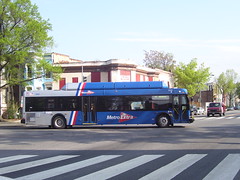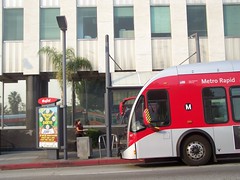(Bus driver) what is the frequency?
WMATA plans to expand "bus rapid transit" according to articles such as this, "Rapid Buses May Be Expanded," subtitled "Metro Proposes New Service Along 18 Crowded Routes," from the Washington Post.
I think this is a good idea, but in some respects misses the point and the opportunity for "re-engineering" processes more generally.
On some bus routes there is a lot of frequency but such high use that the bus doesn't go very fast because it stops a lot, and this can be aggravated by traffic tie-ups. That's where limited stop service (a/k/a "express") is worth considering.
1. Good examples of buses with a lot of frequency but so many stops that it doesn't matter are the lines that go up 16th Street NW (S buses), 14th Street NW (50s buses), and 7th Street NW/Georgia Avenue (70s buses).
So instituting what I call "rapider" or limited stop service such as the 79 bus on Georgia Avenue is a step in the right direction, because the overall trip time can be reduced in significant ways, because the bus makes 25% of the total number of stops it would ordinarily make.

Other bus lines that run into traffic include the 30s line, which is really too long and two different routes combined into one (the east-west line on Pennsylvania Avenue and M Street, and the north-south line on Wisconsin Avenue). Maybe a limited stop service would make sense, maybe not.
2. But a real problem with other lines is lack of frequency. A bus coming every 30 or 40 minutes isn't frequent enough to attract to transit users with choices (it's a line only for people dependent on transit). And the issue to my way of thinking isn't offering "bus rapid transit," but more frequent transit. A perfect example of this are the buses that go up and down Rhode Island Avenue NE-Rte. 1 in Maryland, terminating at the Rhode Island Metro Station.
Who cares about "rapid" transit when the question is just having a decent level of "transit" available to begin with? (See "Metro Transit beefs up service on popular routes: Service so frequent, customers don’t need a schedule" from the Minneapolis-St. Paul Metro Transit Directions newsletter. Note that this is the same point of the Downtown Circulator service.)
3. I don't know how to describe the issues with the G8 line. It doesn't have enough demand to justify "rapid" transit expansion, but the line routing needs to be addressed in order to speed trips. I also do not understand why the service is so f******* bad on that line so often. There are times during rush hour when traffic is delayed on Rhode Island between North Capitol and 4th Street NE, and downtown can be congested. But there is no excuse for many missed buses, and delays of 20 minutes or more. This happens all the time.
I don't like to write too much about bus service failures because I try to focus on the positives of transit. I do think giving bus supervisors the ability to adapt service on the fly when buses bunch, etc. is a good thing. See this Post article, "A Bid for Better Bus Service," for more about this proposal.
4. Speaking of the opportunity to reengineer (see work by Hammer and Champy, and Davenport), there is an opportunity to rebadge buses along the lines of how the MTA does it in Los Angeles with Metro Rapid and Metro Local buses, and to fundamentally rethink service.


The Minneapolis bus service also categorizes bus service by frequency also, using different signage. DC is spearheading this with the MetroExtra service on Georgia Avenue but I think the bus painting scheme is pretty bad, unexciting, and that "Extra" isn't enough.

Minneapolis-St. Paul Hi-Frequency routes are identified on signs with bright red symbols. Metro Transit photo.

Metro Extra Bus Stop Sign, Georgia Avenue NW.
Plus, another way to reengineer bus service is to change and improve it... such as a "bus rapid transit" line on Rhode Island Avenue starting at Dupont Circle (P Street) or around Farragut North (Rhode Island), or both. That could be a cross-jurisdiction limited stop service from Downtown Washington to as far as Greenbelt. Etc.
Labels: business process redesign, transit, transit marketing, transportation planning



0 Comments:
Post a Comment
<< Home